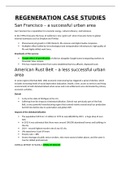Summary
Summary Regenerating Places CASE STUDIES Edexcel A Level Geography
- Module
- Unit 2 - Dynamic Places
- Institution
- PEARSON (PEARSON)
A complete document of all the specification listed case studies required for enquiry questions 1, 2, 3 and 4 of 'Regenerating Places', Topic 4A of Unit 2 in A level Geography (Edexcel). Put together by an A* student. Includes the following case studies: San Francisco as a successful place Ru...
[Show more]




